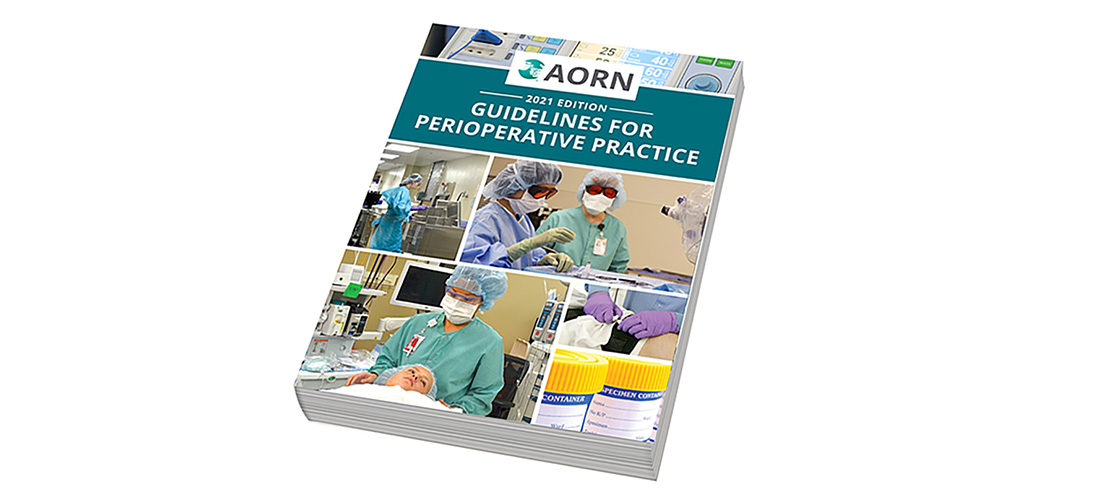2021 Guidelines: 6 Top Practice Updates
By: Aorn Staff
Published: 8/26/2021
Order the AORN Guidelines Today
In 2021, AORN Guidelines for Perioperative Practice are more essential than ever. Get your copy today to receive top clinical guidance with 34 evidence-based guidelines and recommendations, six important updates including infection prevention topics.
2021 Guidelines: 6 Top Practice Updates

The 2021 edition of Guidelines for Perioperative Practice is now available and includes the latest evidence-based recommendations, technologies, and practice needs. There are six updated guidelines that you and your team can implement to keep your patients and each other safe in 2021.
Guidelines Editor-in-Chief Erin Kyle, DNP, RN, CNOR, NEA-BC, reminds us there’s no time like the present, as we move on from 2020, to work together to incorporate crucial practice changes, including critical infection prevention guidance.
“As we move into the new year as the COVID-19 pandemic continues to rage on, it’s important to remember the essential role that perioperative RNs play in leading their teams in delivering safe patient care that is rooted in the best evidence, which is found in the AORN guidelines,” she stresses.
Six Revised 2021 Guidelines
Kyle shares a high-level view of the six guideline revisions to begin incorporating into your organizations policies, procedures, and education today.
- Laser Safety
The Guidelines for Laser Safety and Electrosurgical Safety have been split from what was the Guideline for Safe Use of Energy-Generating Devices. “We heard the perioperative community’s request to split them into their own guidelines to make the recommendations clearer and more accessible,” she says.
Additional practice updates specific to laser safety include a greater emphasis on roles and responsibilities of both organizations and individual team members for laser safety, recommendations for eye protection that are specific to the type of laser used, and new recommendations guide teams in how to include third party laser services in a laser safety program. - Electrosurgical Safety
Practice updates include planning for electrosurgical safety for patients with implanted electronic devices, reporting malfunctions, and using standardized communication when equipment is removed from service, Kyle explains. - Pneumatic Tourniquet Safety
Using limb occlusion pressure to determine the initial tourniquet pressure setting is a new recommendation.
Other updates in this guideline include new recommendations for patient-specific contraindications to pneumatic tourniquets, Kyle shares. For example, “precautions specific to pediatric patients were found in the literature and informed the new recommendation to monitor pediatric patients for respiratory acidosis during procedures where pneumatic tourniquets are used.” - Instrument Care and Cleaning
Practice updates in this guideline emphasize the importance of an interdisciplinary team when selecting equipment and instruments as well as establishing and implementing policies and procedures. “Surgical instruments and devices are complex, and this complexity has led to increasing complexity in manufacturer’s instructions for use for instrument processing. The manufacturer’s instructions for use are of no use to personnel if they cannot access, read, and understand them,” she says. - Care of the Patient Receiving Local-Only Anesthesia
“Patients receiving local-only anesthesia are monitored by a registered nurse rather than an anesthesia professional, so it is imperative that the RN recognize adverse events such as local anesthetic systemic toxicity (LAST) and methemoglobinemia and allergic reactions,” Kyle explains.
To support RNs in identifying such adverse events, this guideline update includes important recommendations highlighting the signs and symptoms that can indicate adverse reactions as well as recommendations for responding to these emergencies. - Specimen Management
The guideline update includes recommendations for handling specimens collected from patients with known or suspected prion disease and handling highly infectious specimens. “This year’s pandemic gave some important perspective to the importance of the recommendations around highly infectious specimens,” Kyle shares.
Another notable update she describes is the addition of recommendations for the use of vacuum-sealed containment. “It is exciting to see research that can support quality specimen containment and preservation that also serves to protect clinicians from the risks of handling hazardous preservation solutions.”
With advances in diagnostics and treatment that include radioactive materials, Kyle says the evidence also supported recommendations for handling and management of sentinel lymph node specimens and radioactive seed localization specimens.

